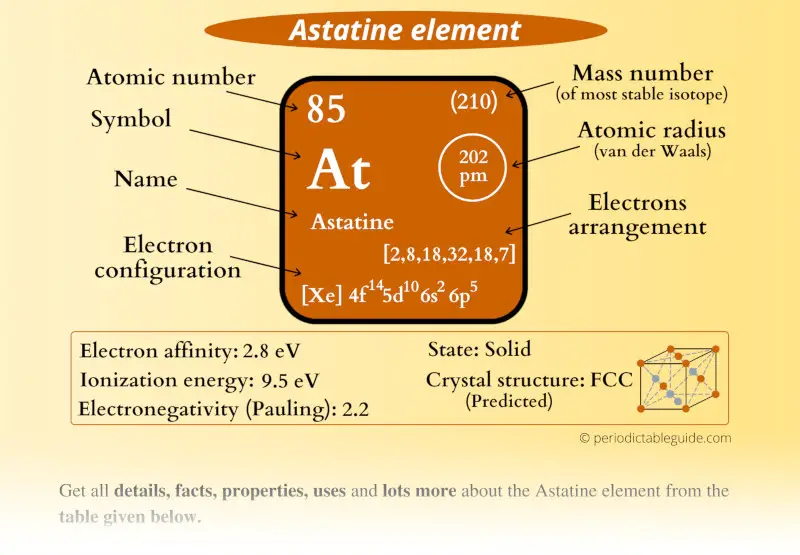
This is a SUPER easy guide on Astatine element.
In fact, the table mentioned below is the perfect information box (Which gives you every single detail about the Astatine element in Periodic table.)
So if you want to know anything about Astatine element, then this guide is for you.
Let’s finish this very quickly.
Astatine Element (At) Information
| Appearance | Dark gray (predicted) |
| State (at STP) | Solid |
| Position in Periodic table | 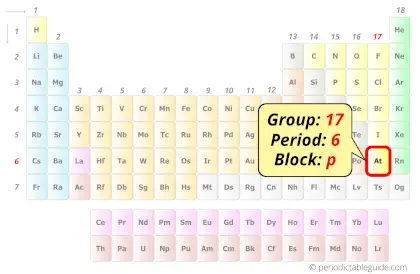 Group: 17, Period: 6, Block: p |
| Category | 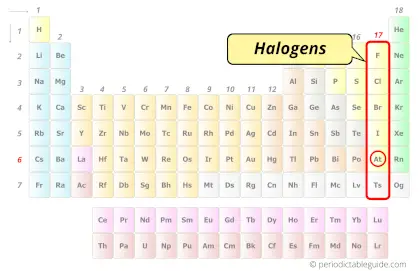 Halogens |
| Atomic number or Protons | 85 |
| Neutrons | 125 |
| Electrons | 85 |
| Symbol | At |
| Atomic mass of Astatine (most stable isotope) | 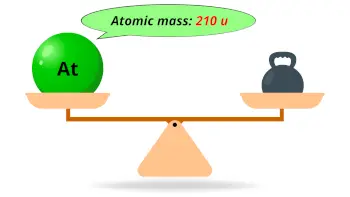 210 u |
| Electrons arrangement or Bohr model | 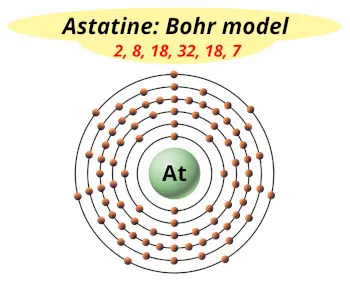 2, 8, 18, 32, 18, 7 |
| Electronic configuration | [Xe] 4f14 5d10 6s2 6p5 |
| Atomic radius | 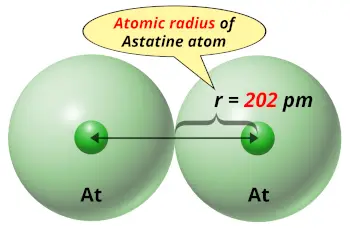 202 picometers (van der Waals radius) |
| Valence electrons | 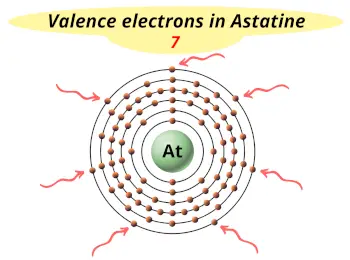 7 |
| 1st Ionization energy | 9.5 eV |
| Electronegativity | 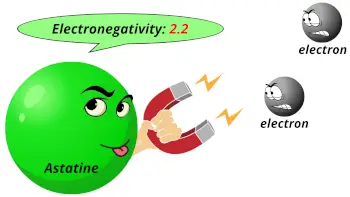 2.2 (Pauling scale) |
| Crystal structure (predicted) | 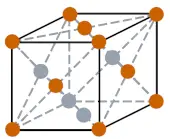 FCC (face centered cubic) |
| Density | no data |
| Main isotopes | 210At and 211At |
| Who discovered Astatine and when? | Emilio Segre, Dale Corson, Kenneth Ross Mackenzie (in 1940) |
| CAS number | 7440-68-8 |
Astatine in Periodic table
Astatine element is in group 17 and period 6 of the Periodic table. Astatine is the p-block element and it belongs to halogens group.
| H | He | ||||||||||||||||
| Li | Be | B | C | N | O | F | Ne | ||||||||||
| Na | Mg | Al | Si | P | S | Cl | Ar | ||||||||||
| K | Ca | Sc | Ti | V | Cr | Mn | Fe | Co | Ni | Cu | Zn | Ga | Ge | As | Se | Br | Kr |
| Rb | Sr | Y | Zr | Nb | Mo | Tc | Ru | Rh | Pd | Ag | Cd | In | Sn | Sb | Te | I | Xe |
| Cs | Ba | La* | Hf | Ta | W | Re | Os | Ir | Pt | Au | Hg | Tl | Pb | Bi | Po | At | Rn |
| Fr | Ra | Ac** | Rf | Db | Sg | Bh | Hs | Mt | Ds | Rg | Cn | Nh | Fl | Mc | Lv | Ts | Og |
| *Ce | Pr | Nd | Pm | Sm | Eu | Gd | Tb | Dy | Ho | Er | Tm | Yb | Lu | ||||
| **Th | Pa | U | Np | Pu | Am | Cm | Bk | Cf | Es | Fm | Md | No | Lr |
←Move to: Polonium (Po) element – Periodic Table
→Move to: Radon (Rn) element – Periodic Table
Why is Astatine in Group 17?
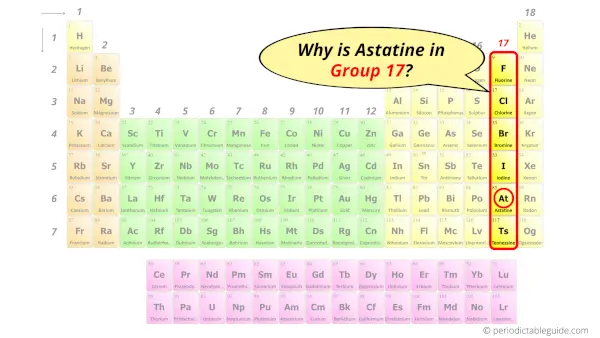
Do you know, how many electrons can be accommodated in the first shell, second shell, third shell, fourth shell, etc…?
Here is the table showing the capacity of orbits to hold electrons.
Number of electrons in shells.
| Orbit / Shell (n) | Maximum no. of electrons this orbit can hold (2 × n2) |
| K shell, n = 1 | 2 × 1² = 2 |
| L shell, n = 2 | 2 × 2² = 8 |
| M shell, n = 3 | 2 × 3² = 18 |
| N shell, n = 4 | 2 × 4² = 32 |
| . . . | . . . |
Thus,
- 1st shell can hold 2 electrons.
- 2nd shell can hold 8 electrons.
- 3rd shell can hold 18 electrons.
- 4th shell can hold 32 electrons.
Now the atomic number of Astatine (At) is 85.
Hence the astatine element has electrons arrangement 2, 8, 18, 32, 18, 7.
This electron arrangement indicates that the outermost orbit of astatine element (At) has 7 electrons.
Hence, it lies in group 17.
Why is Astatine in Period 6?
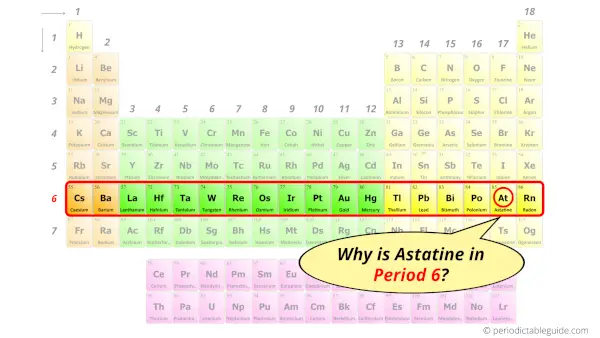
Let me ask you a question.
How many shells does astatine have?
It’s 6. Right?
You have already seen the bohr model of astatine atom in the above table.
From the Bohr model, it can be found that the number of orbits or shells in astatine is 6. Hence, as astatine has 6 orbits, it lies in period 6 of the Periodic table.
Why is Astatine in p-block?
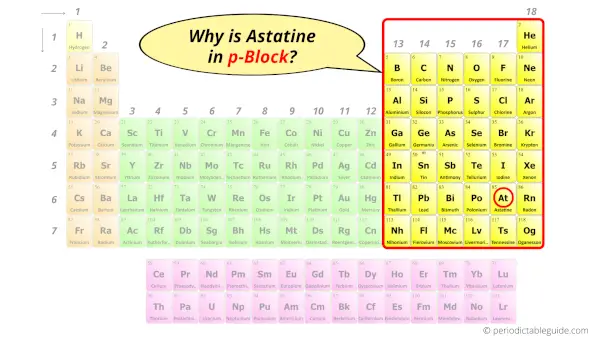
Before knowing this reason, first of all I want to ask you a simple question.
How can you determine the blocks-wise position of elements?
The simple answer: The elements will lie in the s, p, d or f block will completely depend upon the subshell in which the last electron will enter.
For example; the electron configuration of astatine is [Xe] 4f14 5d10 6s2 6p5.
So the last electron of astatine enters the p-subshell or p-orbital.
Hence, astatine is the p-block element.
5 Interesting facts about Astatine
Interesting facts about astatine element are mentioned below.
- The name “Astatine” was derived from the Greek word “astatos”, which means unstable.
- Astatine is a very rare element found in the earth’s crust. Only 25 grams of astatine exist in the earth’s crust at a given time.
- Astatine was discovered by Emilio Segre, Dale Corson and Kenneth Ross Mackenzie in 1940.
- Astatine has around 32 isotopes, and all those isotopes are radioactive in nature.
- The longest live isotope of astatine is 210At, and it has a half life of 8.3 hours.
Properties of Astatine
The physical and chemical properties of astatine element are mentioned below.
Physical properties of Astatine
Physical properties of astatine are mentioned below.
- The predicted appearance of astatine is dark grey color.
- At standard temperature and pressure, astatine is in solid state.
- The predicted atomic mass of the most stable isotope of astatine is 210 u.
Chemical properties of Astatine
Chemical properties of astatine are mentioned below.
- Astatine is a radioactive element and it is available in very less quantity in nature.
- When astatine reacts with metals, it forms salts. This property is similar to halogens (fluorine, chlorine, bromine, iodine, etc.)
- When astatine reacts with hydrogen gas, it forms hydrogen astatide. When hydrogen astatide is dissolved in water, it forms hydroastatic acid.
- Out of all other halogens, astatine shows least chemical reactivity and it shows more metallic nature than any other halogens.
Uses of Astatine
Uses of astatine are mentioned below.
- Currently astatine has not much use except for the research work.
- The isotope of astatine (211At) may be used in treatment of cancer.
- According to some studies, astatine is also found in the thyroid gland in animals.
Explore our New Interactive Periodic Table (with Rotating Bohr Models and More)

Details about this Periodic table:
- Access detailed info on all elements: atomic mass, electron configurations, charges, and more.
- View rotating Bohr models for all 118 elements.
- Get a free HD image of the Periodic Table.
Note: For future use, bookmark this Periodic table or visit “PeriodicTableGuide.com”
External resources:
- Astatine – Element information, properties and uses | Periodic Table. (n.d.). Astatine – Element Information, Properties and Uses | Periodic Table. https://www.rsc.org/periodic-table/element/85/astatine
- Astatine – Wikipedia. (2015, February 24). Astatine – Wikipedia. https://en.wikipedia.org/wiki/Astatine
- P. (n.d.). Astatine | At (Element) – PubChem. Astatine | at (Element) – PubChem. https://pubchem.ncbi.nlm.nih.gov/element/Astatine
- It’s Elemental – The Element Astatine. (n.d.). It’s Elemental – the Element Astatine. https://education.jlab.org/itselemental/ele085.html
- Astatine (At) | AMERICAN ELEMENTS ® (n.d.). American Elements: The Materials Science Company. https://www.americanelements.com/at.html
- CORSON, D. R., MACKENZIE, K. R., & SEGRÈ, E. (1947, January). Astatine : The Element of Atomic Number 85. Nature, 159(4027), 24–24. https://doi.org/10.1038/159024b0
